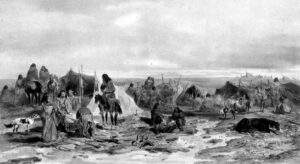A university study offers new information on one of the most enduring mysteries in adventure: How did Chris McCandless die?
Whether it’s from Jon Krakauer‘s original bestseller Into The Wild, or Sean Penn’s dramatic film adaptation starring Emile Hirsch, audiences worldwide have become familiar with McCandless’ tragic story.
A young man who abandoned his possessions and cut ties with family, McCandless spent months traveling alone through the United States’ wild places. In the summer of 1992, he ended up in Alaska, where he crossed the Teklanika River and spent 114 days in an abandoned bus.
After failing to recross the river due to high water, McCandless died later that summer, likely from a combination of starvation and a toxic plant.
In a new study from Oregon State University, two researchers analyzed data about the Teklanika River to answer several questions about the waterway’s role in his death.
“Was there anything anomalous about the summer of 1992 in terms of temperatures or precipitation?” researchers David F. Hill and Christina Aragon asked in their paper.
“Was the increase in flow that prevented Mr. McCandless from re-crossing the river a summer-long increase due to high-elevation snow and glacial melt? Or was it a short-lived pulse due to rainfall?
“In short, this article seeks to add a coda to the story of 1992 by identifying whether or not Mr. McCandless was truly ‘stuck in the wild,’ or simply the victim of unfortunate timing.”
The answer, they concluded, was the second option: plain old bad luck.

Close-up view of the Teklanika River watershed in south-central Alaska. Image: Creative Commons
A ‘very flashy’ river
By leveraging historical data on the Telanika River, the researchers created snowpack and runoff models to estimate water flow at the exact point of McCandless’ attempted crossing.
“Our results demonstrate that the Teklanika River is very flashy during the summer, responding rapidly to strong episodic rainfall events,” Hill and Aragon wrote.
Their findings indicated that snowmelt occurred in mid-to-late May after McCandless first crossed the river. When he tried to recross the river on July 5 (as he wrote in his journal), recent rainfall had also caused a large amount of runoff, they found.
In other words, McCandless picked a tragically bad day.
“We conclude that Mr. McCandless had unfortunate timing and that, had he tried to cross a day or two earlier or later, the outcome may have been different,” the paper said.

A visitor poses with Bus 142, which was removed in 2020. Photo: Creative Commons
An ongoing debate
While the report is interesting, it’s hard to imagine it will render any satisfying conclusion to the continuing debate over how exactly McCandless died.
In his journal, McCandless wrote on July 30, 1992, that ingesting a toxic plant (potato seed) had sickened him to the point that he couldn’t escape. Experts have argued over the plant’s supposed toxicity ever since. Krakauer even wrote an update to the book’s ending in The New Yorker in 2013.
If anything, the study shows that the fascination with McCandless will likely endure. After two people died — and many more required rescues — trying to reach his fateful bus, Alaska officials removed it in 2020.
While many Alaskans still consider McCandless a naive idiot, he remains a symbol of someone who wanted “to experience the raw throb of life without a safety net,” as Krakauer wrote.
That’s a perception no amount of research is likely to change.






